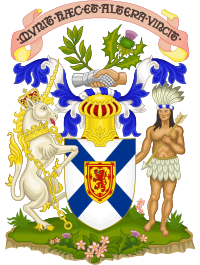Coat of arms of Nova Scotia
| Coat of Arms of Nova Scotia | |
|---|---|
 |
|
| Versions | |

Escutcheon
|
|

With orle of maple leaves, used by the Lieutenant Governor of Nova Scotia
|
|

Arms of the House of Assembly
|
|
| Details | |
| Armiger | Elizabeth II in Right of Nova Scotia |
| Adopted | 1625, readopted 1929 |
| Crest | On a wreath of the colours, a branch of laurel and a thistle issuing from two hands conjoined the one being armed and the other naked all proper. |
| Escutcheon | Argent, a saltire azure charged with an escutcheon of the Royal Arms of Scotland. |
| Supporters | On the dexter an Unicorn Argent armed crined and unguled Or, and gorged with a Coronet composed of crosses patee and fleurs-de-lis, a chain affixed thereto passing through the forelegs and reflexed over the back Gold. And on the sinister a Savage holding in the exterior hand an arrow. |
| Compartment | Grass with the trailing arbutus or mayflower, the floral emblem of Nova Scotia. |
| Motto |
MUNIT HAEC ET ALTERA VINCIT One defends and the other conquers |
| Earlier versions | Or, on a fess wavy azure a salmon between three thistles slipped and leaved proper. (In use from 1867 to 1929) |
The coat of arms of the province of Nova Scotia is the oldest provincial achievement of arms in Canada, and the oldest British coat of arms outside Great Britain. It is blazoned as follows: Argent, a saltire azure charged with an escutcheon of the Royal Arms of Scotland. It was granted in 1625 by King Charles I for the first Scottish colony on the Canadian mainland. The arms are also borne as a heraldic badge by the Baronets of Nova Scotia, a chivalric order of Great Britain.
They fell out of use when Nova Scotia joined the Confederation in 1867, but were restored in 1929 by royal warrant of King George V.
The arms were originally granted in 1625 by King Charles I as part of a Scottish settlement attempt in Nova Scotia led by Sir William Alexander. The arms of Nova Scotia were in use until the mid 19th century. The old arms having been overlooked by Confederation in 1867, a new coat of arms was prepared the following year. This had a salmon on a blue band between three thistles, on a gold field. When the old coat of arms was rediscovered, pressure to restore it grew, and it was reassumed in 1929, with the newer coat being abandoned. The original coat of arms was augmented with a compartment upon the issue of the new royal warrant in 1929.
The 1867–1929 shield may be blazoned Or, on a fess wavy azure between three thistles slipped and leaved a salmon proper.
...
Wikipedia
